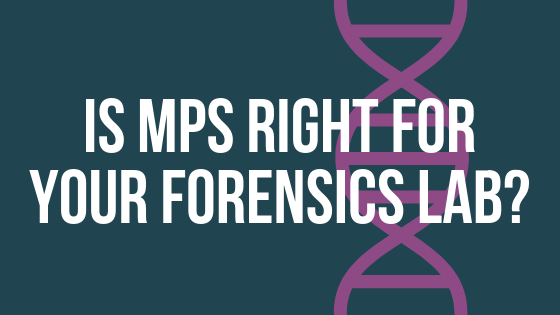Next-generation sequencing (NGS), or massively parallel sequencing (MPS), is a powerful tool for genomic research. This high-throughput technology is fast and accessible—you can acquire a robust data set from a single run. While NGS systems are widely used in evolutionary biology and genetics, there is a window of opportunity for adoption of this technology in the forensic sciences.
Currently, the gold standard is capillary electrophoresis (CE)-based technologies to analyze short tandem repeats (STR). These systems continue to evolve with increasing sensitivity, robustness and inhibitor tolerance by the introduction of probabilistic genotyping in data analysis—all with a combined goal of extracting maximum identity information from low quantity challenging samples. However, obtaining profiles from these samples and the interpretation of mixture samples continue to pose challenges.
Written by: Anupama Gopalakrishnan, Promega
MPS systems enable simultaneous analysis of forensically relevant genetic markers to improve efficiency, capacity and resolution—with the ability to generate results on nearly 10-fold more genetic loci than the current technology. What samples would truly benefit from MPS? Mixture samples, undoubtedly. The benefit of MPS is also exemplified in cases where the samples are highly degraded or the only samples available are teeth, bones and hairs without a follicle. By adding a sequencing component to the allele length component of CE technology, MPS resolves the current greatest challenges in forensic DNA analysis—namely identifying allele sharing between contributors and PCR artifacts, such as stutter. Additionally, single nucleotide polymorphisms in flanking sequence of the repeat sequence can identify additional alleles contributing to discrimination power. For example, sequencing of Y chromosome loci can help distinguish between mixed male samples from the same paternal lineage and therefore, provide valuable information in decoding mixtures that contain more than one male contributor. Also, since MPS technology is not limited by real-estate, all primers in a MPS system can target small loci maximizing the probability of obtaining a usable profile from degraded DNA typical of challenging samples.
Apart from STR loci, MPS kits provide additional primer sets for identification of ancestry, geographical and phenotypic single nucleotide polymorphisms (SNPs), but there are distinct hurdles to adopting them in regular casework. There is simply not enough population data in the database to provide a true assessment of discrimination power and more importantly, the community is yet to arrive at a consensus for reporting guidelines. Moreover, many countries do not allow use of phenotypic and ancestry SNPs in casework. Since technology is complex, simpler kit configurations are easier to adopt in a lab for casework without the burden of analyzing supplementary, unestablished markers. Our PowerSeq™ 46GY System combines unlabeled primers for PowerPlex® Fusion and PowerPlex® Y23 in a single kit and therefore can be used to generate sequence data for existing known STR loci. These loci are widely accepted in the forensic community where adequate population data and reporting guidelines are in place—making the transition to MPS a little bit easier.
Perhaps the easiest path to adoption of MPS is through mitochondrial analysis. Traditionally, mtDNA analysis is performed on these samples using the labor-intensive Sanger’s method. Our PowerSeq™ CRM Nested System offers a streamlined process for library preparation reducing hands-on time for sequencing of the control region of mitochondria. Mitochondrial analysis by current Sanger sequencing method and MPS only differ in the technology or the method by which the data is generated. Unlike STR loci where you are required to view and analyze data differently, current mitochondrial analysis by Sanger Sequencing and MPS both involve comparing the generated sequence data with revised Cambridge Reference Sequence and reporting variants. Therefore, the barrier to adoption of MPS for mitochondrial sequencing is lower than that of MPS for STR sequencing.
While advantages of MPS in forensics cannot be overstated, its widespread adoption is still far from being a reality.
The data generated by STR analysis by capillary electrophoresis (e-grams) is distinctly different from the data generated by STR analysis by MPS (sequence data). So, the two workflows differ in technology and data analysis and interpretation—this warrants a huge training and validation burden on the lab trying to adopt this for casework. Huge efforts in terms of time, resources and money need to be invested for training personnel in MPS process and data analysis.
The MPS workflow is very complicated and involves many steps—the total time taken from sample preparation to results is measured in days. Also, MPS is expensive. The price of reaction per sample still remains very high and cost-prohibitive for use with all casework samples. The only way to reduce cost is by pooling multiple libraries into a single reaction, which is a clear deviation from the current dogma of not mixing casework samples, even inadvertently. Forensic labs would prefer to refer to large data sets from controlled studies that show unequivocally that mixing of libraries generated from multiple samples would not cause data mix up leading to generation of wrong profiles. Many labs are evaluating the technology with reference samples or mock mixtures of purified samples and testing with “real” casework samples has been very limited.
If you are looking to implement a missing persons program or you are working with cold cases or mass disasters, you may have a unique subset of samples that could benefit from MPS technology. We hope to provide the resources and support you need so that the path to implementing MPS in your forensic lab is an easy transition.
WOULD YOU LIKE TO SEE MORE ARTICLES LIKE THIS? SUBSCRIBE TO THE ISHI BLOG BELOW!
SUBSCRIBE NOW!


